| |
On this page: | Introduction | Stratigraphy | Hydrogeology| Buried metal and objects | Hydrocarbons | Geophysical work |
A two-page PDF version of this page.
Introduction
This report presents work carried out by ____ Contracting Inc., in 19xx. The Figure to the right shows the location of area in relation to the inlet south of the city's downtown area as it was around 1980, roughly a decade before our work was done. The history of industrial activity is fairly complex, and covers over 100 years. For example, the photograph below shows some of the wood waste mixed in with the fill under the pavement at this location. More details about the history are available elsewhere, but are beyond the scope of this summary.
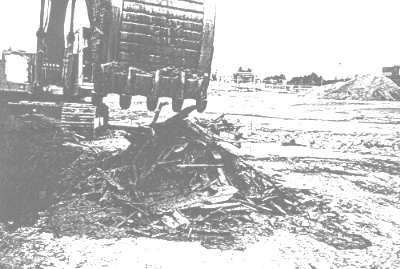
The next figure is a sketch showing all test pits and boreholes used in the course of this work, as well as other features of the site. Notice for example the blue fence line, and the outlines of previous facilities like oil transformer pits, etc. With respect to this map, the stratigraphic section sketched below runs top to bottom within a few metres of the west (left) edge of the red square. |
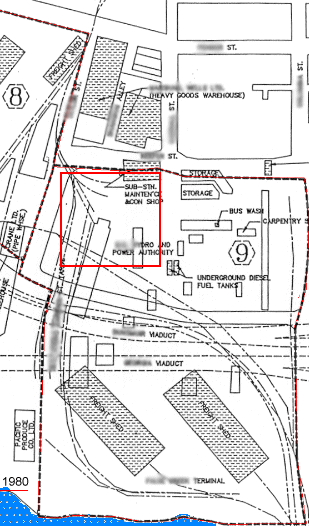 |

Stratigraphy
Based on monitoring wells, boreholes and trenching the north-south cross section shown to the right was constructed. The five primary stratigraphic units in the area of interest can be described as follows.
- The top half metre consisted of two layers of very hard pavement.
- The fill below was very variable, consisting mainly of mineral fill, but with considerable quantities of other materials, including buried metal and concrete, wood waste, construction debris and gravel fill. Individually, these materials have a wide range of physical and geotechnical properties, and when used as fill, bulk (averaged) properties would also range widely. Photograph 1 above gives some indication of what is meant by "wood waste". Identifying elevation highs and lows may provide some insight as to where more (or less) compressible fill materials existed.
- The next unit below the artificial fill was a sandy silt (or silty clay in some areas), ranging between zero and one metre thick.
- The deepest layer penetrated by boreholes was a very dense gray sandy silt, with some gravel and traces of clay - basically a till. The depth to this till is moderately well-constrained under the profile to the west of the field site.
- Sedimentary bedrock was reportedly deeper than 20 m.
|
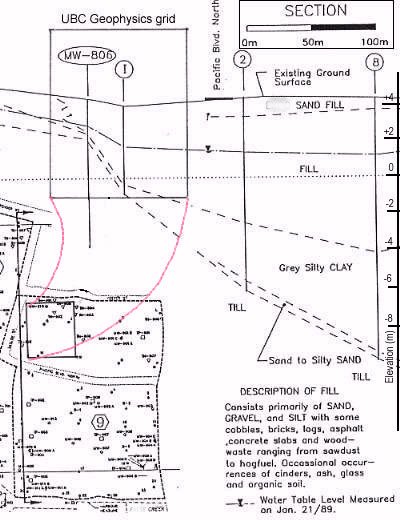
|
Hydrogeology |
The depth to the water table was known to vary between 1 and 3 m, with flow generally towards the South West. The principle hydrostratigraphic unit (fill) was generally highly permeable but with isolated regions that appeared to block flow through this aquifer. Transformer oil contaminated with polychlorinated biphenyl (PCB) was found in boreholes and test trenches floating on the water table 2 m to 3 m below ground surface in some parts of the northern half of the field site.
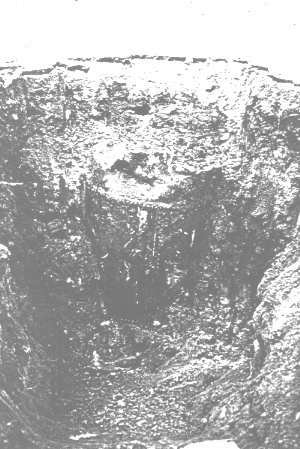 In two of the test pits, high inflows of water (and some oil) were observed in zones of coarse wood waste characterized by open voids up to 10 cm in size In two of the test pits, high inflows of water (and some oil) were observed in zones of coarse wood waste characterized by open voids up to 10 cm in size
Buried Metal and Objects
Many kinds of buried objects were encountered in the fill layer. There was much buried metal including wires, tanks, and other known and unknown objects. Photograph 2 to the right shows a buried tank found at test pit 28. A buried oil sump was also expected in the location of the oil house associated with the maintenance shop near the North edge of the site. It is also possible that re-bar reinforced concrete foundations of buildings or supports for the old traffic Viaduct could be encountered. There were also old railways, although no evidence of the iron rails themselves was found in trenches or boreholes. Above ground, there are several lamps, and a chain link fences surrounds our study area on three sides. The lamps are expected to be connected to underground wiring since they are not fed by overhead wires.
Hydrocarbons
Early in our work, a monitoring well was discovered to have up to 20 cm of oil floating on the water table, containing concentrations of PCB's higher than the local special waste regulations permitted. As a result, an investigation program was conducted to delineate the areal extent and thickness of the oil, to assess the PCB concentrations, and to locate any potential remaining sources of oil such as underground tanks. The investigation involved excavation of 36 test pits, and collection of 7 oil samples, 58 soil samples, and 10 water samples. Details about all boreholes and test pits are contained in a separate report. We recommend that geophysical surveys be conducted in order to further delineate contaminated zones, and to locate subsurface features that might be associated with oils. This is because the largest concentrations of PCB's were found in black stained soil inside or adjacent to buried pipes and transformer parts. This increases the importance of investigating all geophysical anomalies that could be buried metal debris.
PCB concentrations were measured in 58 soil samples with results as shown to the right. Most of the contamination was found within the depth range of 1m to 3m, which corresponds to the fluctuation of the water table. Samples from five standpipe locations were used to characterize the oil itself, in terms of carbon distribution, viscosity, specific gravity and flashpoint. The oil / water contact was found to be blurred even after samples gathered from standpipes had been left to stand for 24 hrs. The diffuse layer between oil and water was inferred to consist of emulsified oil possibly resulting from weathering due to microbial activity over the extended time period. Note that this probably has important implications for detection using geophysics for at least two reasons: i) the interface between water and oil is not manifested as a distinct transition in physical properties, and ii) there are in effect three fluids rather than two - water, oil, and the mixture. |
 |
Geophysical work
In the remaining chapters of our report, the design and results of four surveys are presented. Data are be shown in more or less processed forms depending upon the type of data. Most figures are in colour, and there are interactive pages that contain multiple data sets, to be used for comparison of multiple data sets.
A map outlining the 100m x 100m area of the geophysical survey area, and showing borehole and test pit locations, was given above. The figure to the right shows elevations across this 100m x 100m area, with locations of geophysical surveys. The North-South seismic refraction line is labelled in red, GPR was performed at 1m station intervals along North-South lines (spaced 4 m apart) within the box labelled GPR, elevation was measured at the dots, and EM-31 and gradient magnetic surveys occupied the whole area on a 2m grid. The line labelled VLF-R will not be discussed at all in this report. It is one of four other surveys carried out at this site including multiple frequency EM, time domain EM, VLF (very low frequency) EM, and gravity. |
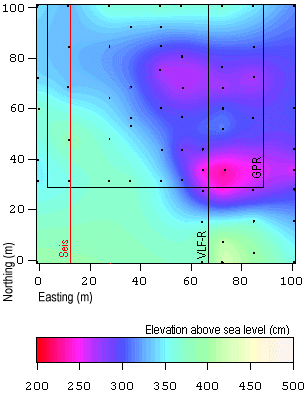 |
This concludes the summary of geologic information obtained by our study.
|
|

